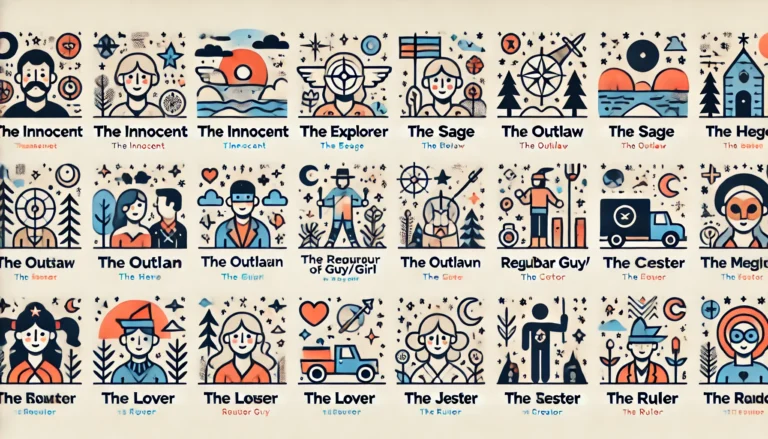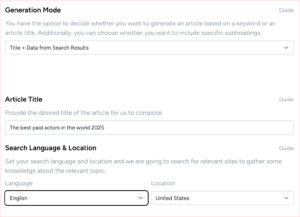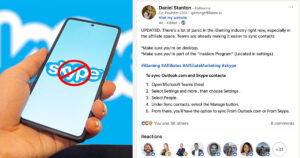We are delighted to announce our latest feature enhancement in our text generation engine – the “Intended Audience” feature. This feature is designed to cater to the 12 Brand Archetypes, allowing our engine to generate text that will resonate more deeply with your specific target audience.
You can find the Brand Archetype settings in the Article Settings.
What are the 12 Brand Archetypes?
According to psychologist Carl Jung, archetypes are universal, recurring symbols or motifs that appear across different cultures and eras.
The concept of Brand Archetypes is based on that idea. It was invented by marketing professionals Carol S. Pearson and Margaret Mark. They identified the 12 specific archetypes in their book, “The Hero and the Outlaw: Building Extraordinary Brands Through the Power of Archetypes.” (Available as a FREE PDF here).
Their 12 archetypes each symbolize basic human motivations which brands can cater to.
The archetypes also have really cool names, but what else would we expect from marketing geniuses?
- The Magician: Brands that position themselves as magicians are seen as visionary and spiritual. They make dreams come true and create something special from ordinary things. Examples include Disney and Apple.
- The Outlaw: Also known as the Rebel, these brands represent liberation and revolution. They challenge the status quo and advocate disruptive innovation. Harley Davidson and Virgin are classic examples.
- The Hero: Hero brands are all about mastery, courage, and great strength. They aim to improve the world and inspire others to do the same. Nike is a classic hero brand.
- The Lover: These brands are all about intimacy, passion, and relationships. They often appeal to people’s desires and aspirations. Victoria’s Secret and Hallmark fall into this category.
- The Jester: Also known as the Joker, these brands are about fun, irreverence, and living in the moment. They aim to bring joy to people’s lives. Examples include Ben & Jerry’s and Old Spice.
- The Everyman: Also known as the Regular Guy/Girl, these brands are about belonging, being a part of the community, and connecting with others. Brands that fit this archetype include Ikea and Levi’s.
- The Caregiver: These brands are all about service, care, and altruism. They seek to help and protect others. Johnson & Johnson and UNICEF are examples.
- The Ruler: Ruler brands represent power, control, and leadership. They are often luxury brands that people aspire to. Examples include Rolex and Mercedes-Benz.
- The Creator: These brands are about innovation, imagination, and creativity. They encourage self-expression and aim to create enduring value. Lego and Canon are examples.
- The Innocent: Innocent brands represent simplicity, purity, and nostalgia. They aim to recreate paradise and evoke childhood memories. Coca-Cola and Dove are classic examples.
- The Sage: Sage brands are about wisdom, truth, and intelligence. They seek to understand the world and provide insights. Google and The New York Times fall into this category.
- The Explorer: Lastly, explorer brands represent freedom, adventure, and discovering new frontiers. They encourage people to experience more of the world. The North Face and Jeep are examples.
Examples of text written differently for the 12 Brand Archetypes
Let’s say you have just released a new awesome groundbreaking digital product (like our text generation tool), and you want the news about it to be tailored to your audience. Here is how the feature would be described differently for each brand archetype.
- The Magician: “Our groundbreaking technology empowers you to transform your everyday tasks into extraordinary experiences.”
- The Outlaw: “With our bold technology, dare to challenge the norm and break free from traditional constraints.”
- The Hero: “Our robust technology is designed to empower you, helping you conquer challenges and triumph over adversity.”
- The Lover: “Our technology fosters deeper connections, creating a web of intimacy and understanding in your digital interactions.”
- The Jester: “Our technology adds a splash of fun to your day, turning mundane tasks into moments of joy and delight.”
- The Everyman: “Our user-friendly technology is designed for everyone, making the digital world more accessible and welcoming.”
- The Caregiver: “Our technology is your dependable companion, always there to assist and guide you in your digital journey.”
- The Ruler: “Our premium technology puts you in control, commanding power and prestige in your digital domain.”
- The Creator: “Our innovative technology sparks your creativity, helping you bring your unique ideas to life.”
- The Innocent: “Our technology offers a safe and simple solution, bringing peace of mind to your digital experience.”
- The Sage: “Our advanced technology enlightens, providing wisdom and insights to navigate the digital landscape.”
- The Explorer: “With our innovative technology, you’re free to embark on new adventures and explore the limitless possibilities of the digital world.”
Know your audience
As you can see above, it’s important to know who you are selling to. If your product is a baby monitor and the target audience is first time parents, then “The Lover” would be a better choice than “The Outlaw”.
“The Lover” represents intimacy, care and connection, which parents strive for. The Outlaw represents rebellion and disruption. First-time parents are likely looking for products that provide safety, care, and peace of mind for their children, attributes more closely associated with “The Lover” archetype.
It’s more subtle than this in our text generation
Our AI text generator writes long pieces of text with lots of facts, well suited to get traffic from search engines. This means however that it’s not a long series of marketing sentences. There are subtle differences in the text here and there.
If you know your audience and your site is following a specific tone of voice, choosing the right archetype will help you.
Subtle yet powerful influence
It may be subtle, but the impact isn’t diminished.
Remember, these archetypes tap into Carl Jung’s concept of the collective unconscious, universal themes resonating within all of us at a deep level. They may not be overt, but their influence is profound, subtly aligning your brand with your audience’s intrinsic motivations.
So, even if the archetype’s presence seems subtle in the text, it’s connecting with your audience in a powerful, intuitive way which elevates your brand’s message.
How to use it
Log in to your Topcontent/AI-account and then select your Brand Archetype in the Article Settings.

If you don’t already have an account, get one: the first 5 articles are free.





